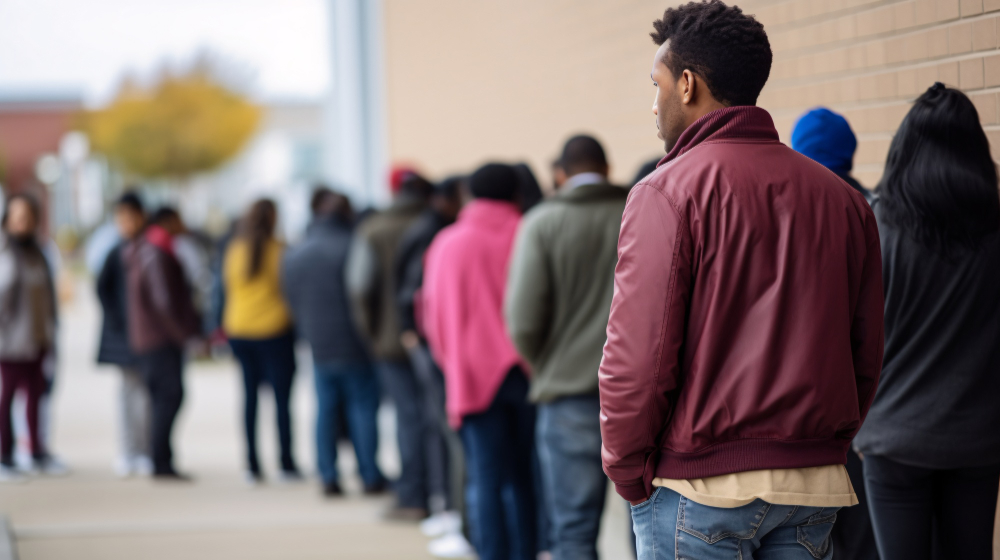- 14 3402-5578
- Rua Hygino Muzy Filho, 737, MARÍLIA - SP
- contato@latinoobservatory.org
The presidential election campaign of 2024 in the United States promises to be one of the most turbulent and controversial in recent memory, taking place in a society riven by discord over even the basic facts and by disparate understandings about what the national realities, values, and goals are or should be. Or what kind of “America” or vision for the country they are talking about. Further, as a Gallup Poll noted, “The 2024 election is expected to match a historically unpopular incumbent president with a former president whom voters previously rejected for a second term.” Many of the negative trends in the United States, such as distrust of the “establishment”and the mainstream news media, the rise of populism, political polarization, hostility for “expertise,” fake news and deliberate disinformation, doubts about election security, threats of political violence, and the questioning of democracy itself, are also seen around the world, including in Brazil. The United States is becoming decidedly less “exceptional.”
While Americans will be presented with a parade of details and sharp contradictions, focused to the present moment, often set within inflammatory and apocalyptic partisan rhetoric, it would be helpful to the Brazilian observer to keep in mind the “big picture” of the major current characteristics of American political culture and public opinion within which these details will be playing out. A focus on political culture goes beyond public opinion about particular events and personalities of a moment in time to examine the more enduring, broader, and deeper perceptions, norms, understandings, attitudes, identities, and patterns that a population or a sector of that population develop and rely on to guide their political behavior.
Several principal underlying dynamics that will be at work during 2024 are identified in this essay, with reference to recent reliable polling data, to encourage the reader to research further on their own. Suggestions of reliable online resources to follow the election are included, for the same purpose. In accordance with the apparent circumstances at the time of this writing, the Joe Biden vs. Donald Trump contest is the context for any specific situational observations.
Major Trends and Tendencies to Watch in 2024
American dissatisfaction with how their democracy is working is rising across the board, raising urgent questions about the strength and durability of the system of governance that has long characterized the United States, and which it has usually spoken for around the world for decades. Gallup (January 2024) found that “A new low of 28% of U.S. adults are satisfied with the way democracy is working in the country,” noting that the decline over a two-decade period is particularly sharp among Republicans and persons with less formal education. Pew Research (September 2023) noted that “Americans’ views of politics and elected officials are unrelentingly negative, with little hope of improvement on the horizon… Positive views of many governmental and political institutions are at historic lows… A growing share of the public dislikes both political parties… Nearly two-thirds of Americans (65%) say they always or often feel exhausted when thinking about politics, while 55% feel angry.” Authoritarian sentiments and a preference for autocracy are found in both parties, but are especially strong among the populist and intransigent MAGA Republicans radicalized under Trumpism, who are firmly set against compromise with Democrats. There is a widespread awareness that “democracy is on the ballot” in 2024, but each side cites quite different reasons for why that is so and blames the other for the threat. A survey by the Public Religion Research Institute (October 2023) found that “nearly a quarter of Americans (23%) agree that ‘because things have gotten so far off track, true American patriots may have to resort to violence in order to save our country,’ up from 15% in 2021.”
The two major parties each feel beleaguered and are operating within two largely separate streams of news and interpretation, with dialogues that are mutually antagonistic. Inter-party hostility is sharp, and animosity against the other side (as in “good” vs. “evil”) is a major force for party unity and consequent deep mutual distrust and polarization on many issues. The communication flow within each partisan stream tends to paint an alarming picture of constant serious threats from advances being made by the other side. As a result, a large-sample YouGov poll (December 2023) noted that “Liberals see the U.S. as moving to the right while conservatives see it moving to the left.” According to a Pew survey (February 2024), “most Americans (71%) say that, on the issues that matter to them, their side in politics has been losing more often than winning.”
A dissatisfaction with the stale two-party system is implicit in the fact that the number of voters who identify as “Independents” is increasing, relative to those who identify with the two major parties. Gallup posted in January 2024 that “Political independents continue to constitute the largest political bloc in the U.S., with an average of 43% of U.S. adults identifying this way in 2023... Equal 27% shares of U.S. adults identify as Republicans and Democrats, with the Democratic figure marking a new low for that party in Gallup’s trend.” Many Independents, however, tend to vote repeatedly for the same party when forced to choose at the polls. For several reasons, even though there is an ongoing but abstract public opinion interest in alternatives, the U.S. two-party sytem very effectively frustrates the emergence of any third party.
Party identification alignments in the various subgroups of the population are shifting gradually, as the Republicans successfully mold their party into a more populist champion of concerns for the rural and small-town populations, the working class, and those of lesser education (but ironically now led by an ostentatious multi-billionaire from New York City). According to Gallup, in late 2023:
“The largest advantage among demographic subgroups that either major-party group had over the other in party preferences in 2023 is Democrats’ 47-percentage-point lead among non-Hispanic Black adults. Two-thirds of Black adults (66%) identify as Democratic or lean that way, whereas 19% identify as or lean Republican. Democrats also have strong advantages in the leaned party identification of nonreligious adults, postgraduates and residents of big cities, and they hold a solid nine-point lead among women. Republicans’ greatest pockets of strength are with people who attend religious services weekly (leading Democrats by 26 points among this group) and residents of towns or rural areas (+25). The GOP holds smaller double-digit advantages among Protestants, White adults, men, non-college-educated adults, residents of the South and semi-regular church attenders.”
The electorate as a whole will express opinions for pollsters, but has a relatively low level of attention to and knowledge about even major and basic specific facts, issues, and policies. For an example concerning the demographics of the national population, a YouGov poll in March 2022 concluded that “From millionaires to Muslims, small subgroups of the population seem much larger to many Americans…When people’s average perceptions of group sizes are compared to actual population estimates, an intriguing pattern emerges: Americans tend to vastly overestimate the size of minority groups.” A CNN poll released in February 2024 showed that “only a quarter of voters seek out news about the campaign; a third pay little to no attention at all.” A January 2024 YouGov poll showed that “only a bit over half of the country on average is aware of the various legal challenges Trump faces,” which are being heavily covered in the mainstream media. A minority of Republicans showed awareness of his various legal charges, in the same poll. Details aside, most voters already have rather firm opinions about Trump and Biden as individuals and as leaders, and a majority of voters are not enthusiastic about a Trump-Biden rematch in 2024. Strongly pro-Trump voters are a notable exception, still believing that Trump was the true victor in the November 2020 election.
Popularity statistics about the presidential candidates at the national level are sometimes referred to as “horse race” statistics about who is “ahead” at the moment in the preference polls, but are not indicative of the probable state-by-state results in the Electoral College which actually determines the winner. There are only a few really competitive states remaining, which will decide the election, mainly Arizona, Georgia, Michigan, Nevada, Pennsylvania, and Wisconsin (according to The Economist). Another “swing state” assessment about the effects of the Electoral College adds the states of Minnesota, New Hampshire, and North Carolina to that competitive list, and so concludes that, regarding election of the president, “41 states and DC (with 80% of the U.S. population) will be spectator states in 2024.”
The massive immigration of millions of individuals into the United States across the southern border in recent years has become a major concern in public opinion and a widely-perceived risk to America’s very national identity. Republicans tend to prioritize it more highly as a major problem and to support harsher methods to dissuade and to punish illegal immigrants than do Democrats. In a January 2024 CBS News poll, 72% of registered Republican voters agreed with Trump’s comment that illegal immigrants are “poisoning the blood of our country,” and 82% if Trump was identified as the source. But even legal immigration is a partisan issue. In July 2023, Gallup concluded “Currently, 73% of Republicans, matching the prior high from 1995, want immigration decreased, while 10% want it increased, meaning their net preference for more immigration is -63. By contrast, 40% of Democrats want it increased, while just 18% want it decreased -- a +22 net preference score. Independents still tilt negative, with 27% wanting it increased and 39% increased, or -12.”
Misinformation, disinformation, “fake news,” shameless lying, false narratives, and conspiracy theories are certain to play a significant role in the campaign, including about election integrity and the credibility of the results, particularly among strong partisans. Most of the distortion is internal in origin, from what the RAND research firm calls “truth decay,” deeming it a threat to national security; i.e. “the safeguarding of people, places, and the American way of life.” But foreign actors interested in weakening the United States will also be operating, attempting to erode Americans’ trust and confidence in their leaders, institutions, and democracy itself, working especially through social media. The wise researcher will do very careful fact-checking. The journalism-oriented Nieman Lab states, with some hope, “New research suggests people in the U.S. are, overall, good at identifying true political news headlines from fake ones — but there are some stark socioeconomic differences.”
Suggested Websites to Follow the American Election Process in 2024
For those Brazilian academics and students who seriously follow American elections and their campaigns as they unfold, reliable resources include the ACE Electoral Knowledge Network, Ballotpedia, Polls and Votes, Gallup Poll, Pew Research, The Marist Poll, Civiqs, The Public Religion Research Institute, ABC News’ 538, The New York Times’ U.S. Politics, The Washington Post’s Politics, CNN Politics, PBS News Hour’s Politics Section, The Fox News Poll, The Cook Political Report, The Conversation, The Bulwark, Sabato’s Crystal Ball, Real Clear Politics (https://www.realclearpolitics.com/) and Politico (https://www.politico.com/). Most of these sites are cost-free and provide a means to receive updates and breaking news by email. The C-Span TV channel posts many relevant videos on its Campaign 2024 site. The flood of campaign-relevant videos found on YouTube, on the other hand, are of drastically varying veracity and analytical insight, often tending to favor emotional impact and to reinforce partisan predispositions-- may the user beware!
Media bias and the extent of the large disparity in what is covered and given meaning by the conservative versus the liberal media (almost separate dialogues or two versions of “the truth”) are shown dramatically by Ground News, especially in the “Blindspot” section. The large AllSides website is excellent for a broad objective introduction and guide to hundreds of American news sources and their left-center-right biases, if any. This site also has a useful Red Blue Translator to explain common phrases in current partisan usage, and a section covering the 2024 presidential election. Regarding ongoing partisan-oriented fact-checkers, the Media Research Center focuses on criticism of the left-wing media and popular culture, while Media Matters for America is a critic of the right-wing news media and reporting.
More broadly, the U.S. National Archives publishes a list of U.S. Voting and Election Resources, and the U.S. government maintains an official website on voting and elections. The reader may also wish to consult the wide range of additional resources linked and annotated in my 2021 article for OPEU, “Suggested Cost-free Online Resources for U.S. Politics and Foreign Policy.”











